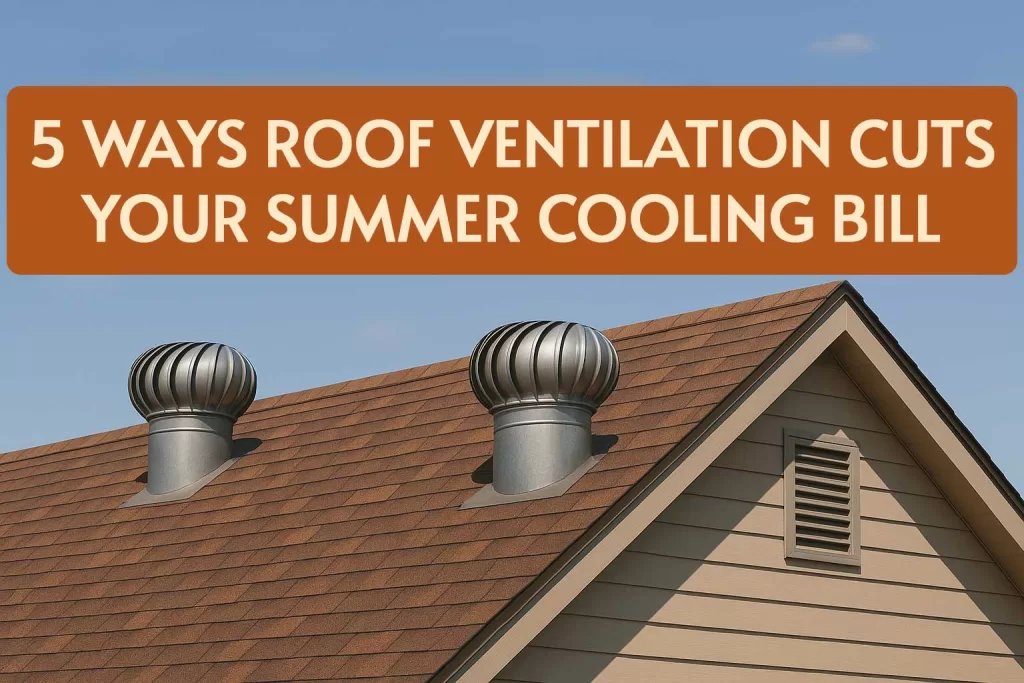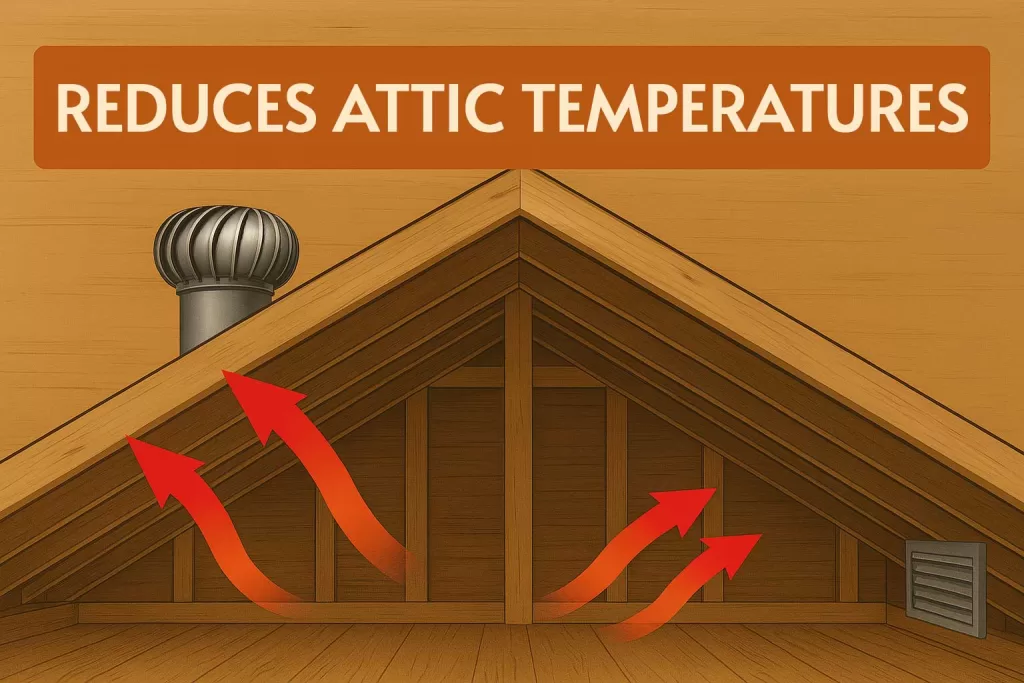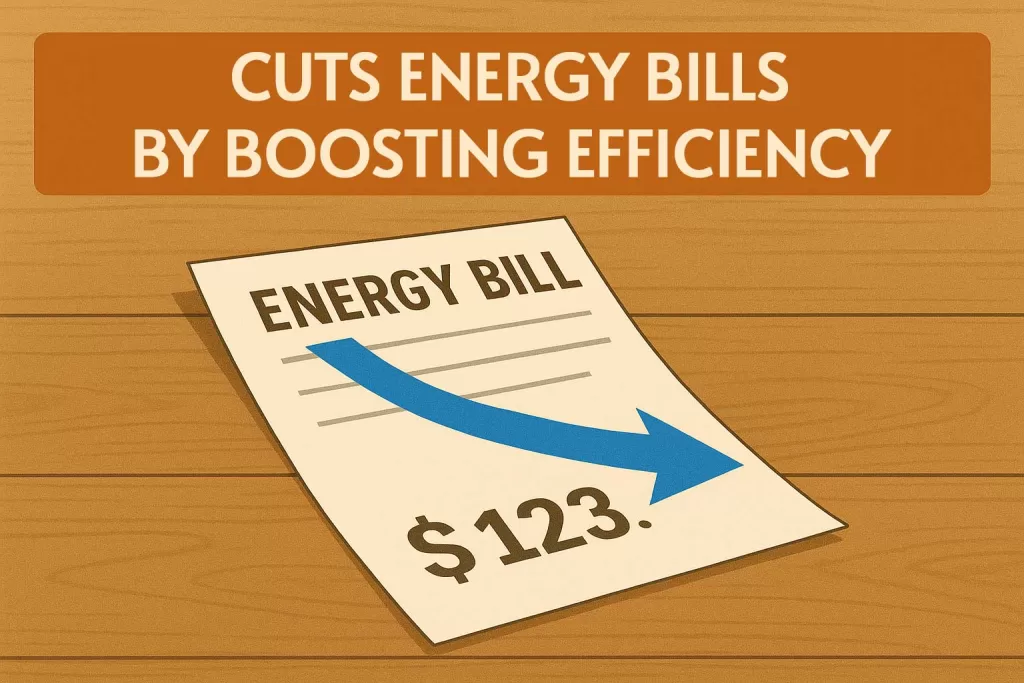


Every summer, like clockwork, my energy bill shoots up! I used to think running the AC 24/7 was the only way to survive the heat. But a few years ago, after one especially scorching July, I decided to do some research. That’s when I discovered something that completely changed how I cool my home: roof ventilation!
I’ll be honest, I had no idea how much heat was getting trapped in my attic. It turns out, the air up there can reach over 150°F! All that hot air was radiating down into my living space, forcing my air conditioner to work overtime. After installing a few whirlybird vents in strategic locations, my attic temperature dropped significantly. And so did my summer cooling bill!
If your home feels like a sauna in the summer and you are always switching on the AC, your roof might be the cause. The good news? You can fix it AND save money by harnessing the power of roof ventilation!
In this post, I’ll share 5 powerful ways roof ventilation can cut your summer cooling bill. At the end, I’ll share with you how I went about choosing my roof ventilation system and how to install it. Let’s get started so we can all cool our homes down as soon as possible!
Why Does Roof Ventilation Matter?
Before I really understood how my home worked, I never gave roof ventilation much thought. But after talking to a local roofer and doing some research, I realised it plays a huge role in how comfortable your home is and how much your monthly energy bill costs!
Without proper ventilation, your attic becomes a giant heat trap. On a hot day, the temperature up there can soar to unbearable levels, and all that heat starts to radiate downward. That means your upstairs rooms get hotter, your AC runs longer, and your energy bill gets more expensive.
Proper roof ventilation allows trapped hot air to escape and brings in cooler outside air which keeps temperatures balanced. Roof vents, soffit vents, and whirlybird vents all work together to keep airflow moving naturally.
Now that we know why roof ventilation is important, let’s explore the five ways it can reduce your summer cooling bill.
#1: Reduces Attic Temperatures

Once I got serious about roof ventilation, I realised just how hot my attic could get during the summer, sometimes over 150°F! That kind of heat doesn’t just stay in the attic. It seeps down through the ceiling and raises the temperature inside your living space, especially upstairs bedrooms.
Before I added better roof ventilation, my air conditioner was constantly running, struggling to keep up. Once I installed a few whirlybirds, the difference was incredible! My attic stayed significantly cooler, and I found myself not using the AC nearly as much.
When your attic stays cooler, your home stays cooler, and that directly translates to energy savings. I saw a noticeable drop in my monthly bill, and it all started with controlling the attic temperature through proper ventilation!
#2: Encourages Passive Ventilation
One of the most underrated benefits of roof ventilation is that it creates a passive cooling system! This is a natural airflow cycle that works without electricity or effort. Once I understood how it worked, I realised my roof could literally help cool my house for free!
Here’s how it works: cool air enters through low intake vents (like soffit vents), while warm air rises and escapes through high exhaust points, like whirlybird vents. This natural airflow pulls heat and moisture out of the attic, even on calm days. It’s called passive ventilation because it relies on basic physics, not fans or power!
After I added a few vents and two whirlybirds to my roof, I noticed a steady drop in attic temperatures. That consistent air movement reduced how much heat built up in my home during the day.
Because passive ventilation runs 24/7, it eases the burden on your AC system. Less trapped heat equals less energy needed to cool your home! And of course, that leads to a lower summer energy bill.
#3: Reduces Moisture & Improves Air Quality

When we think about summer problems, we usually focus on heat, but moisture can be just as damaging. I learned this the hard way when a home inspector found early signs of mould in my attic insulation! The cause? Poor roof ventilation allowed humid air to collect and linger.
During the summer, hot air holds more moisture. Without proper ventilation, that moisture gets trapped in your attic, leading to condensation, mould growth, wood rot, and even a musty smell that can drift into your living areas. This build-up can seriously affect your health! A report by the Victoria Government Better Health website warns that “Mould associated with damp buildings can trigger nasal congestion, sneezing, cough, wheeze, respiratory infections and worsen asthma and allergic conditions.”
Once I installed more vents and added two whirlybirds, though, the airflow improved dramatically. That constant movement of air kept humidity in check. My attic stayed dry, my insulation remained effective, and the air inside my home felt fresher and cleaner.
While this may not directly impact your energy bill, it still affects your wallet. Moisture damage leads to expensive repairs, such as replacing insulation, drywall, or roof decking. And poor indoor air quality can aggravate allergies or respiratory issues, which no one wants to deal with.
Good roof ventilation helps protect your home’s structure and your family’s health while also saving you money on problems caused by mould and mildew growth!
#4: Extends Roof & HVAC System Lifespan
Excessive attic heat does more than just make your home uncomfortable! If you don’t ensure proper ventilation, it can bake your roof from the inside out. Your shingles will age faster, the wood can warp, and the insulation breaks down. At the same time, your HVAC system is working overtime to fight that heat, which leads to more wear and tear!
Since adding proper ventilation and a couple of whirlybirds, I’ve used my air con a lot less. Less strain means fewer repairs and a longer lifespan for both your roof and HVAC system, which can save you thousands in the long run on replacements and energy costs.
#5: Cuts Energy Bills by Boosting Efficiency

What surprised me most after improving my roof ventilation wasn’t just the cooler attic—it was how everything in my home worked better. From the thermostat to airflow through the vents, my entire cooling system felt more balanced. That’s because roof ventilation doesn’t just remove heat—it helps your HVAC system operate under optimal conditions.
Without trapped heat in the attic, the AC doesn’t have to run longer cycles or fight to cool hot spots. My energy usage smoothed out, and I stopped seeing those sharp spikes during heatwaves. Plus, since whirlybirds require no electricity, they improved airflow without adding to my utility bill.
Good ventilation helps your whole home run more efficiently, and that efficiency directly impacts what you pay each month. For me, the savings were noticeable within the first billing cycle, and over time, they really add up!
How to Get Started with Roof Ventilation
If you’re ready to make your home cooler and more efficient, roof ventilation is a great place to start—and it’s easier than you might think. When I realised how much heat and moisture were building up in my attic, I decided it was time to take action. After doing a bit of research (and speaking with a local roofer), I chose to install a combination of soffit vents and two whirlybird vents on the roof. If you’re unsure which one to choose, consider checking out this blog I found, which offers advice from roof ventilation experts: Whirlybirds vs Solar Roof Ventilators: Which is Right for Your Home?
I didn’t try to DIY it because I wanted to make sure the job was done right. So I hired a licensed roofing contractor with experience in ventilation systems. We walked through my attic space, measured the square footage, and worked out how many vents I needed based on the general rule of 1 square foot of ventilation per 300 square feet of attic space (split evenly between intake and exhaust).
The soffit vents provided fresh, cool air from below, and the whirlybird vents worked as wind-powered exhaust to draw out hot air. The installation was done in a day, and the difference was noticeable within a week: cooler upstairs rooms, less humidity, and a quieter AC unit. And when my energy bill came round, it was significantly lower!
If you’re not sure where to begin, I’d recommend getting a roof inspection or speaking to a local contractor who understands ventilation design. Every home is different, and the best system depends on your roof style, climate, and attic size!
For me, adding proper roof ventilation was a small investment with a big payoff. I’m now enjoying lower energy bills, a more comfortable home, and the peace of mind that my roof and HVAC system are protected for years to come! If you’re tired of your home being too hot, consider giving roof ventilation a try!
